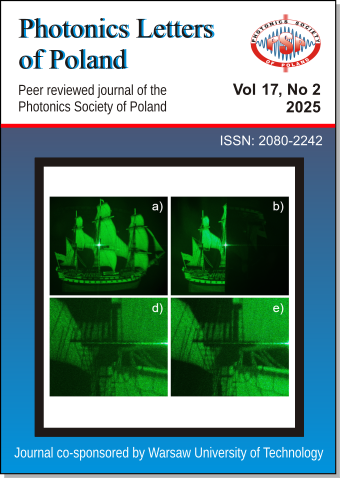Fiber-Optic Sensor for Detecting PFAS Compounds in Water Using a Fabry–Pérot cavity
DOI:
https://doi.org/10.4302/plp.v17i2.1344Abstract
A PVDF‐coated Fabry–Pérot fiber‐optic sensor was developed for rapid in situ detection of PFAS in water. A low‐finesse etalon was formed by dip‐coating, yielding interference minima that shift by an average of 5 nm during wet–dry cycling (SD = 0.7 nm). Exposure to a 10 µg/mL PFOS solution induced a reversible 5.9 nm redshift, and subsequent rinsing restored the baseline within 0.4 nm. The sensor’s low cost, portability, and high repeatability make it well suited for field applications.
Full Text: PDF
References
- Carbon-Fluorine Bond Strength, Alfa Chemistry Fluoropolymers Resource, DirectLink
- Z. Abunada, S. Safi, A. Ahmad, M.M.F. Chitta, "An Overview of Per- and Polyfluoroalkyl Substances (PFAS) in the Environment: Source, Fate, Risk and Regulations", Water 12(12), 3590 (2020), CrossRef
- C.F. Kwiatkowski, M.L. Cannon, D.T. Hoffman, J.A. Buck, S.A. Fedorak, "Scientific Basis for Managing PFAS as a Chemical Class", Environ. Sci. Technol. Lett. 7(8), 532 (2020). CrossRef
- P. Radek, K. Barczak, A. Olszewska, Optical fiber sensor for per- and polyfluoroalkyl substances (PFAS) in Proc. Integrated Optics - Sensors, Sensing Structures and Methods, IOS'2025, Szczyrk, Poland, Feb. 24-28, 2025, p. 81. DirectLink
- F. Faiz, S.J. Mihailov, D. Thapa, V. Kayunkid, G. Viney, "Polyvinylidene fluoride coated optical fibre for detecting perfluorinated chemicals", Sens. Actuators B Chem. 312, 128006 (2020). CrossRef
Downloads
Published
How to Cite
Issue
Section
License
Copyright (c) 2025 Patryk Radek

This work is licensed under a Creative Commons Attribution 4.0 International License.
Authors retain copyright and grant the journal right of first publication with the work simultaneously licensed under a Creative Commons Attribution License that allows others to share the work with an acknowledgement of the work's authorship and initial publication in this journal. Authors are able to enter into separate, additional contractual arrangements for the non-exclusive distribution of the journal's published version of the work (e.g., post it to an institutional repository or publish it in a book), with an acknowledgement of its initial publication in this journal. Authors are permitted and encouraged to post their work online (e.g., in institutional repositories or on their website) prior to and during the submission process, as it can lead to productive exchanges, as well as earlier and greater citation of published work (See The Effect of Open Access).




